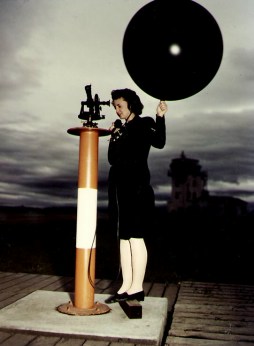Pilot Weather Balloon (Pibal) Optical Theodolites - Equipment - Operations and
Related information.
Updated 11-25-2009
 |
WAVE Aerographer's Mate 3rd Class
Dorothy J. Baroch stands ready to launch a weather balloon from a
theodolite platform, circa 1944-45. N.A.S. Moffet Field California.
Image from: Naval
Historical Center
Quiz: For you pibal experts...This picture was posed, what is wrong with it? & Extra Credit: What model is the theodolite? Answers |
New items: J.J. Hicks Pilot Balloon Slide Rule Mark I, Warren-Knight 20-9xxx series, Troughton and Simms c1921, Clarkson SM1, Chinese 70-1, Buff & Buff ML-47 and Warren Knight 20-9103
Below is a compilation of information and links that I have collected in research on Pilot Balloon (Pibal) Optical Theodolites procedures and related items. Pibals and theodolites have a important history in meteorology. They have been used to track upper level winds for over 125 years. Their use is now restricted to a limited number of specialized but often critical applications, usually in remote locations where usable data from a Rawinsonde is not available. Ironically pibals are still utilized to support the flights of manned balloons, (hot air balloonists) the application they were originally developed for.
Basic Definition:
A pilot weather balloon (Pibal) theodolite is a device
that is similar to a surveyor's transit. It consists of a telescope mounted on two
movable axes. One axis (vertical) rotates to change elevation, the other
(horizontal) azimuth. There are vernier scales and in some cases micrometers that
give precise readouts of the relative position of the telescope to each axis. Unlike
the surveyor's transit a pibal theodolite utilizes a "bent axis telescope".
Additionally a pibal theodolite often has the facility to illuminate the crosshairs and
readouts for night time use. A diagram of a commonly used pibal theodolite is
illustrated here. Specialized units were produced
for shipboard use, one is illustrated here.
Basic Operation:
The instrument is set up so that it is level and it is pointed towards true north with both scales reading 0 degrees
exactly. A balloon is released in front of the theodolite. It is sighted at
timed intervals (usually one minute apart) and the position of the theodolite's telescope (azimuth and
elevation) is recorded.
Why do we do this:
We can chart the direction and velocity of winds at various altitudes just by watching
balloons. The rate of ascent of a balloon is
mostly dependant on the balloon's drag and its "free lift" (the vertical pull of
the balloon). We have some degree of control over these these factors, and as a
result, know approximately how high our balloon will be at any given time after its
release. Given a known height and an angular direction (read off the theodolite) to
the balloon, we can fix the horizontal movement component of the balloon's travel as it
moves through different altitudes. The horizontal movement is due to the winds
blowing the balloon around at the altitudes that the balloon is traveling through.
When better accuracy is desired, two spaced theodolites can be used to site the balloon in synchronized intervals. The two theodolite solution does not require assumptions of the ascent rate. The position is solved in 3D and the resulting wind data will tend to be more accurate.
Pages and topics on this site include:
Pibal Theodolite Manufacturers Info. (current production models)
Pibal Theodolite Models and Info. (historical models I
have acquired and documented)
Pibal Accessories and historical items
Pibal publications, software and information
Pibal Theodolite procedures for set up and observation of a balloon
Important information about this site:
This site contains information is for casual informational purposes only. This site
is not affiliated with any manufacturer or reseller of equipment or services.
I have attempted to summarize information that I have received on these products and make
no official claims or representations of the product line offered by any company listed on
this site.
Please send comments, corrections, additional materials that can be included to: mbrenner@csulb.edu Martin Brenner, Director of Technology, College of the Arts, California State University Long Beach, 1250 Bellflower Blvd. Long Beach CA 90840
Things I am still looking for:
Breithaupt Pilot Balloon Theodolite, MK I and MK III pilot balloon
slide rules, Morin (France) Pilot Balloon Theodolite.
Acknowledgements:
I would like to thank Mr. Graham Bartlett of the National Meteorological Library &
Archive, London for providing materials essential to this site, Rick Marron at
Warren-Knight, Bob Summersett of Customcraft, Herb Gold and Dr. Michael Douglas and the National Severe Storms Laboratory for
providing information on US Weather Service (now NOAA) pattern theodolites.
My
colleagues at California State University Long Beach, Library and the College of the Arts
for allowing the use of facilities, equipment and Web space to support this research and
Web Site. Last but not least the folks at www.palosverdes.com
for hosting the files and the website.








